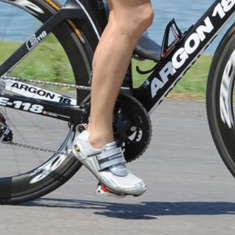With triathlon season warming up and the JLL Property Triathlon on the horizon at the end of June, we asked our soft tissue therapist and Triathlon Coach Emily to give us her best tips for preparing for your triathlon. She’s even given her top tips for racing at Dorney Lake:
Getting ready for JLL Property triathlon
(or other triathlons at Dorney Lake)
Dorney Lake is an ideal venue for a sprint distance triathlon - pancake flat course and calm lake water to swim in. It’s beginner-friendly and a good place for seasoned triathletes to gauge their fitness. After competing in more than a dozen races there, I’ve come up with some useful Dorney-specific tips to make your race day as smooth as the lake.
Getting there
From London, you can take your bike on to the train to Windsor & Eton Riverside or Windsor & Eton Central. From there, it’s a 3.5 mile ride to Dorney Lake, perfect for warm up. Be sure to ride down Bovney road which will get you to the start line side rather than the car park side at the far end of the lake. Take a look at this map.
If you are driving, make sure you get there at least 1.5 hours before your wave starts, so you have time to park and get down to the other end of the lake to register and check in.
Swim: Sighting
Normally, I would suggest to my athlete to sight every 6 strokes or so, and trust no one in a race. At Dorney Lake, the small buoys are actually attached to each other under the water like a lane rope. So depending on where your starting pontoon is, sight for the first buoy, from there, keep your head down and follow the ropes underneath to complete the swim lap.
For those of you who are doing the 2.2 km swim, the trick to holding a straight line is a symmetrical stroke. Bilateral breathing, enter your hands into the water at 10 o’clock and 2 o’clock position with good full body rotation.
Bike: Counting laps
This is by far the trickiest part of the whole race… counting to 4 is surprisingly difficult when in race conditions… you can use 4 bits of sticky tape on the handle bar where you would take one off per lap, just be sure to remember whether you did it at the start of the lap or at the end of the lap (can you see now how confusing it could get?)
A bike computer is useful, just remember to start it, and that GPS can be slightly out. Unlike other sprint tri’s the bike course is 21.2 km.
Transition
For a sprint distance triathlon, every seconds count in transition. Think how hard it would be to take 1 min off your 5km run time or your 750 m swim time In transition, all it takes is to be calm and a little bit clever:
Lay out your transition with the shoe holes facing you; sunglasses open and inside helmet; helmet straps open with its inside facing up so you can flip it on to your head; race belt under your shoes ready to be stepped into.
Transition layout.
Practice dismounting your bike on the fly:
Kirsty demonstrating a flying dismount.
If you’re a strong swimmer, ditch the wetsuit and use a swim skins tri suit instead. (At that time of the year, it is likely for a race there to be wetsuit optional).
Instead of bike shoes and clip-in (aka clipless) pedals, you can use courier straps on flat pedals and trainers. That way, you can roll straight off the bike and on to the run, for a 20km flat ride, bike shoes and clipping in make negligible difference (I’ve tried both multiple times).
Whether you use road cleats, MTB cleats or just trainers with straps, such a flat course at short distance, it makes no difference.
Instead of wearing socks, put plenty of talc powder in your shoes and go sock-less.
Wind
Dorney Lake is always windy, for some reason you’ll get a constant side or head wind wherever you are in the bike lap. This is the place for Time Trial bikes if you have one, if you don’t, practice riding on the drops and stay low. Make sure whatever you’re wearing is tight fitting and nothing is flapping about.
Pack list
Trisuit (wetsuit if you’re wearing one, lube for your neck)
Goggles (you may want tinted ones if it’s sunny)
Running shoes
Talc powder
Race belt for putting your race number on
Bike in good working order
Helmet
Sunglasses
Bike shoes if you’re using them.
Image by Scott Collier Photography.
Good luck, have fun!
Words by Emily Chong. Image by Scott Collier Photography.






